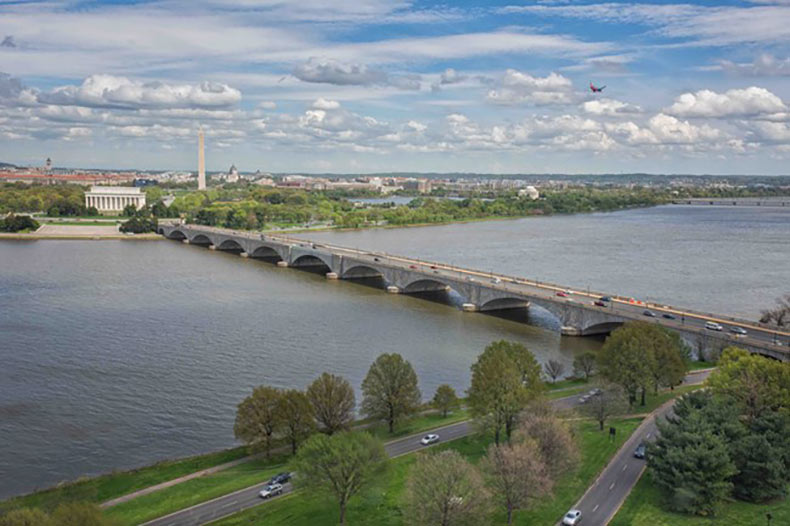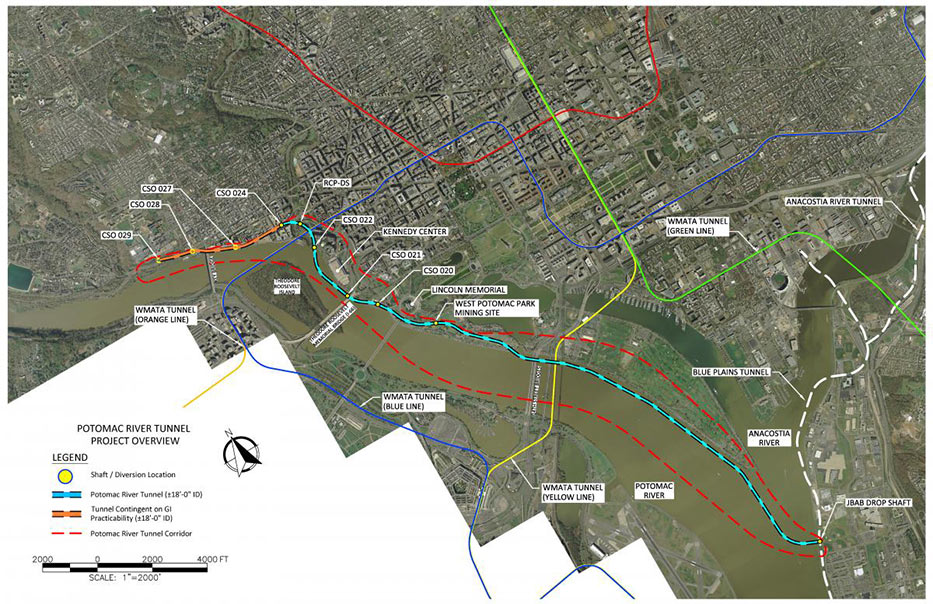Potomac River CSO approved in Washington DC 16 Apr 2020
The last of the large tunnel contracts in the Washington DC Clear Rivers CSO project has received environmental approval from the National Parks Service to permit construction of the project mostly on and under its lands. The 5 mile (8km) long x 18ft (5.5m) diameter tunnel will run along the east shore of the Potomac River passing beneath parks and gardens of the famous Washington DC riverside and alongside famous landmarks including the Lincoln Memorial and the Kennedy Centre Concert Hall.
The new tunnel along with diversion facilities, drop shafts and support structures, will intercept combined stormwater overflow outlets on the Potomac from existing sewer networks and divert flow southwards, under the confluence with the Anacostia River, to join the first tunnel of the Clear River project for conveyance to the Blue Plaines wastewater treatment plant (Figs 1 and 2). An estimated 654 million gallons of CSOs currently enter the Potomac River in a year of average rainfall. The Potomac tunnel will reduce that volume by 93% and reduce the frequency of overflow events from about 74 events a year to four. Green infrastructure options are also being studied as part of the overall Clean Rivers CSO control project.
According to Brandon Flora, a Project Manager with DC Water, the utility owner of the Clear River project, the tunnel will run 100ft to 150ft deep and will be a TBM with a precast concrete segmental lining along the same design as the previous Blue Plain, Anacostia, First Street tunnels and the current Northeast Boundary tunnel project.
If green infrastructure is determined practicable, the project will require construction of four new shafts, according to Flora. If green infrastructure is determined impracticable, the tunnel will be extended to include CSO number 029 and there will be a total of seven new shafts. In addition, the tunnel will connect to existing shafts at CSO 021 and at the Joint Base Anacostia-Bolling.
Flora confirmed that an industry outreach for the construction contract will begin next Spring (2021) with a request for qualification anticipated in late 2021. Following evaluation, an anticipated date for inviting the shortlisted groups to tender is mid-2022 for a start of construction in Summer 2023. The current budget for the Potomac tunnel project is between US$450 million and $550 million.
With most of the construction taking place on Nation Parks Service (NPS) land, an environmental assessment was completed to evaluate two alternatives: a no-action option and an action alternative for the tunnel. A finding of no significant impact was signed by the NPS Acting Director of the National Capital Area on 30 March 2020, selecting construction of the Potomac River tunnel as the preferred alternative and concluding the National Environmental Policy Act (NEPA) process. The Clean Rivers project by DC Water is developed to comply with the 2005 Federal Consent Decree and as amended January 2016 to have the full project in operation by 2030.
“We have seen the tremendous performance of the Anacostia River tunnel,” said DC Water CEO and General Manager David Gadis, “and we know the planned project will dramatically improve the health of the Potomac.”
“Clean water is vital to the environment and the people who live, work and play nearby,” said acting NPS National Capital Area Director Lisa Mendelson-Ielmini. “After seeing the early successes of the Anacostia system, we are excited to think of the possibilities for the Potomac.”
DC Water began its $2.6 billion Clean Rivers Project in 2011 to construct 18 miles (near 30km) of deep, large diameter CSO and stormwater storage tunnels to deliver all captured flow to the Blue Plains treatment plant (Fig 2). Within the Program Consultants Organization for the overall project for DC Water, McMillen Jacobs Associates is the general consultant overseeing tunnel and geotechnical engineering.
In addition to the Blue Plains, Anacostia and Potomac CSO tunnels, the Northeast Boundary flood prevention project began in 2012. A new storage tunnel under First Street was completed in October 2016 and the new 27,000ft long x 23ft diameter (8km x 7m) Northeast Boundary trunk sewer was awarded in mid-2017 to the Salini Impregilo/Healy (Lane Construction) JV, after the same JV was awarded the Anacostia River tunnel of the CSO program in mid 2015 with design-build engineering partner Parsons. After completing excavation of the 3.8km x 7m i.d. Anacostia River tunnel in November 2016, the team refurbished the 8m diameter Herrenknecht EPBM for reuse on the Northeast Boundary tunnel.

TBM breakthrough on the Northeast Boundary tunnel
After launch on the Northeast Boundary contract in September 2018, the TBM excavated more than 15,600ft (4.75km) and broke through into the W Street shaft on 9 April. The TBM is scheduled to resume excavation of the final 11,000ft (3.25km) in early May. Overall, including construction of the diversion structures and drop shafts, the project is approximately 46% complete and is to be completed to meet the in-service operating date of the Northeast Boundary and the Anacostia tunnel in 2023.
The 7km x 7m i.d. Blue Plains tunnel was completed by the Traylor/Skanska/Jay Dee JV with design engineer CH2M-Hill and using an 8m diameter Herrenknecht EPBM. The completed tunnel was placed into operation in 2018 and has captured more than 7 billion gallons of combined sewage since then. Upon completion in 2030, the overall DC Clean Rivers Project, including the Northeast Boundary and Potomac tunnels will reduce the volume of combined stormwater overflows into District waters by 96%.
References
- Final push for cleaner waterway in Washington DC – TunnelTalk, July 2018
- DC Water awards NEBT to Healy/Impregilo – TunnelTalk, July 2017
- DC calls qualifiers for city’s longest tunnel as Blue Plains tunnel holes through – TunnelTalk, September 2015
- DC Water starts on major CSO program – TunnelTalk, October 2011
|
|
|
|
|
Add your comment
- Thank you for taking the time to share your thoughts and comments. You share in the wider tunnelling community, so please keep your comments smart and civil. Don't attack other readers personally, and keep your language professional.




